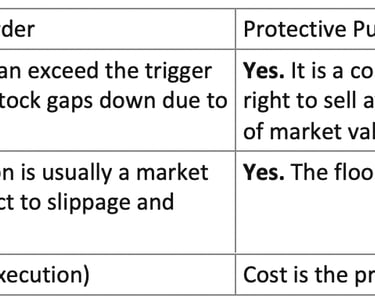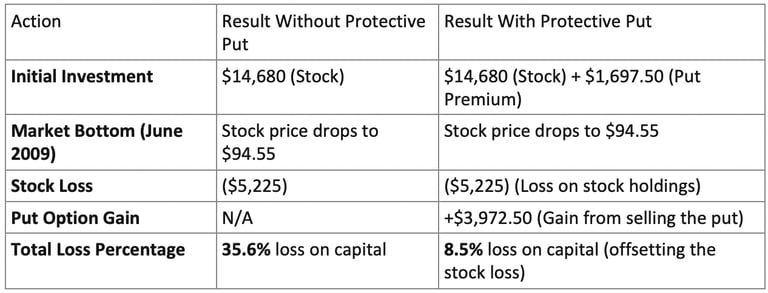Protective Put Options: The Insurance Against Market Crash
Master the Protective Put Options strategy for market crash protection. Learn how this options insurance provides a secure floor price and limits maxi loss.
INVESTMENT STRATEGY
Ben T.
10/17/20255 min read


Bulletproofing Your Portfolio: How Protective Put Options Act as Cheap Insurance Against Market Crashes
The specter of a market crash—where disciplined wealth-building vanishes in swift, brutal declines—is the chief anxiety of every serious investor. In times of rising uncertainty or high valuations, traditional buy-and-hold investors often feel entirely helpless, resorting to panic selling or simply enduring catastrophic losses.
However, elite investors and financial professionals view market risk differently. They use tools specifically designed to manage risk and neutralize these downturns. Options, which were invented primarily to reduce risk, are the perfect vehicle for this purpose.
Among all options strategies, none is more essential for the prudent investor seeking portfolio hedging than the Protective Put. This strategy is the financial equivalent of buying a homeowner’s or auto insurance policy for your stocks. It is one of the simplest and most effective strategies, offering a guaranteed "sell" button for your shares, regardless of how far the market plummets.
The Protective Put: The Essential Seatbelt for Your Stock Holdings
A Protective Put strategy is straightforward: it is a combination of owning the underlying stock and simultaneously buying a put option contract against those shares.
Defining the Put Option
A Put Option gives the buyer the right, but not the obligation, to sell a specific number of shares at a predetermined strike price before a fixed expiration date.
• If the stock price falls, the value of the put option increases, thereby offsetting the loss in your stock position.
• If you choose to purchase a put for insurance, the most you can lose is the initial price you paid for the contract, known as the premium.
When you execute a protective put, you establish a guaranteed floor price for your stock. If your stock drops, the put ensures you can sell it at the strike price, effectively limiting your maximum loss to the premium paid.
Core Benefits of Protective Puts (Options Insurance)
1. Guaranteed Capital Preservation: The strategy contractually limits your maximum loss, regardless of the severity of a market crash.
2. Limited, Known Cost: Your risk is clearly defined and limited to the cost of the premium. Losing this small, known cost is always preferable to losing potentially thousands in capital.
3. Unlimited Upside Retention: You still own the underlying shares. If the stock price rises, you participate fully in the gains, and the put simply expires worthless (costing only the premium).
4. Peace of Mind: You purchase the confidence to hold your long-term investments without panicking during volatile periods


Strategic Insights: When Protective Puts Make the Most Sense
The Protective Put is not a tool to be used haphazardly, but strategically deployed when risk signals are flashing red.
Ideal Market Conditions for Protective Hedging
Protective Puts provide the highest value during specific periods of market uncertainty:
• Before Volatility Spikes: If you anticipate an event that could cause rapid, unpredictable price swings, such as a major earnings announcement or critical macroeconomic data (e.g., interest rate decisions). You want to purchase insurance before the volatility shock sends put prices soaring.
• High Valuations and Correction Fears: When stocks appear highly valued, and fundamental analysis suggests a correction is overdue. You can maintain your long position but use a put to hedge the inevitable pullback.
• Uncertain Political/Global Events: When significant world events, like presidential elections, have the power to sway an entire index.
Protective Puts Contrasted with Stop-Loss Orders
Many beginner investors rely on stop-loss orders—instructions given to a broker to automatically sell a stock if the price drops to a certain level. While simple, this method carries substantial risk:


The primary advantage of the protective put is that it insulates you from the possibility of the market jumping your stop-loss level thanks to a lack of liquidity or excess volatility. You pay a small price for this essential protection.
Alternatives: Collars and Diversification
While the Protective Put strategy is ideal for simplicity and pure protection, other portfolio hedging options exist:
• Diversification: Investors often seek complex ways of hedging by investing in assets like gold, silver, or cryptocurrency. While these may bring capital gains, they do not provide the contractual protection or additional cash flow stream that options can.
• Collar Strategy: A collar is a three-legged position that adds a short covered call to the protective put. The credit received from selling the call offsets the cost of buying the put, thereby reducing the net expense of the protection. While collars are wonderfully flexible, the protective put stands out for its simplicity and easier management, making it an excellent starting point for new options traders
Risks and Limitations of Protective Puts
As with any investment strategy, it is critical to understand the costs and required discipline associated with using protective puts.
• Cost Erosion: The premium paid for the put option directly reduces your overall net profit. For long-term investors, the cost can add up if you constantly renew the put, potentially sacrificing stock returns over time.
• Time Constraint: Options have a limited lifespan and will expire. The protection is not permanent; if the stock doesn’t drop in value, the put expires worthless, and you must purchase a new one to continue the insurance coverage.
• Options Basics Required: Although simple to execute (often requiring only a Level 1 brokerage account), successful utilization requires the discipline to stick to a plan and a foundational understanding of options terminology, strike price selection, and expiration dates.
Illustrative Example: Insuring an Investment
Consider the bear market of 2007–2009. An investor bought 100 shares of SPY (S&P 500 ETF) at $146.80 on December 20, 2007


The option insurance purchased allowed the investor to offset the majority of the capital loss by selling the put for a profit, transforming a devastating 35% decline into a manageable single-digit loss
Conclusion: Embrace Options as a Professional Risk Management Tool
The Protective Put strategy is not a complicated derivative used by Wall Street titans; it is a straightforward, common-sense tool that provides cheap insurance against catastrophic losses. By defining your maximum risk upfront, you fundamentally change your relationship with market volatility. You are no longer hoping for the best; you are managing the worst.
Options, when used smartly and in moderation, transform from a perceived gambling tool into an intelligent investor’s best friend. The goal of sound investing is not avoiding all losses but managing risk effectively. The Protective Put allows you to do exactly that, securing your capital while you patiently ride the long-term uptrend of the market.
We encourage you to explore the power of options as a professional portfolio hedging tool. In an investment landscape characterized by unpredictable global events and rapid, algo-driven price movements, embracing tools like the protective put is no longer optional—it is essential to guarantee your financial longevity and preserve your hard-earned wealth.


